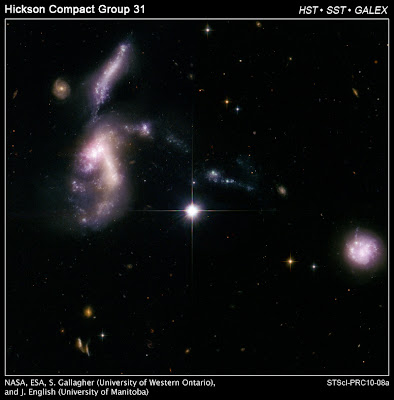Galaxies throughout the universe are ablaze with star birth. But for a nearby, small spiral galaxy, the star-making party is almost over.
Astronomers were surprised to find that star-formation activities in the outer regions of NGC 2976 have been virtually asleep because they shut down millions of years ago. The  celebration is confined to a few die-hard partygoers huddled in the galaxy's inner region.
celebration is confined to a few die-hard partygoers huddled in the galaxy's inner region.
The explanation, astronomers say, is that a raucous interaction with a neighboring group of hefty galaxies ignited star birth in NGC 2976. Now the star-making fun is beginning to end. Images from NASA's Hubble Space Telescope show that star formation in the galaxy began fizzling out in its outskirts as some of the gas was stripped away and the rest collapsed toward the center. With no gas left to fuel the party, more and more regions of the galaxy are taking a much-needed nap.
"Astronomers thought that grazing encounters between galaxies can cause the funneling of gas into a galaxy's core, but these Hubble observations provide the clearest view of this phenomenon," explains astronomer Benjamin Williams of the University of Washington in Seattle, who directed the Hubble study, which is part of the ACS Nearby Galaxy Survey Treasury (ANGST) program. "We are catching this galaxy at a very interesting time. Another 500 million years and the party will be over."
NGC 2976 does not look like a typical spiral galaxy. It has a star-forming disk, but no obvious spiral pattern. Its gas is centrally concentrated, but it does not have a central bulge of stars. The galaxy resides on the fringe of the M81 group of galaxies, located about 12 million light-years away in the constellation Ursa Major.
"The galaxy looks weird because an interaction with the M81 group about a billion years ago stripped some gas from the outer parts of the galaxy, forcing the rest of the gas to rush toward the galaxy's center, where it is has little organized spiral structure," Williams says.
The tsunami of gas racing toward the center has fueled rapid star birth for at least the past 500 million years in the relatively armless disk. At the same time, star birth ended in the galaxy's outer regions because the gas ran out. Now, the inner disk is running out of gas as new stars burst to life, shrinking the star-birth zone to a 5,000-light-year-wide area around the core.
"At one point during this process, the density of gas in the inner regions of this galaxy was very high, about five times higher than it is today," explains Julianne Dalcanton of the University of Washington, and leader of the ANGST team. "The gas vanished incredibly fast, and the galaxy now appears to be settling down."
Astronomers pieced together this star-formation story with the help of Hubble's sharp vision. The galaxy's relatively close distance to Earth allowed Hubble's Advanced Camera for Surveys (ACS) to resolve hundreds of thousands of individual stars. By studying those stars, the astronomers determined their color and brightness, which provided information about when the stars formed. The astronomers combined the Hubble results with a map, made from radio observations, showing the current distribution of hydrogen across the galaxy.  The map is part of The HI Nearby Galaxy Survey by the National Radio Astronomy Observatory's Very Large Array in New Mexico. By analyzing the combined data, Williams and the team then reconstructed the star-making history for large areas of the galaxy.
The map is part of The HI Nearby Galaxy Survey by the National Radio Astronomy Observatory's Very Large Array in New Mexico. By analyzing the combined data, Williams and the team then reconstructed the star-making history for large areas of the galaxy.
"This type of observation is unique to Hubble," Williams says. "If we had not been able to pick out individual stars, we would have known that the galaxy is weird, but we would not have dug up evidence for a significant gas rearrangement in the galaxy, which caused the stellar birth zone to shrink toward the galaxy's center."
Simulations predict that the same "gas-funneling" mechanism may trigger starbursts in the central regions of other dwarf galaxies that interact with larger neighbors. The trick to studying the effects of this process in detail, Williams says, is being able to resolve many individual stars in galaxies to create an accurate picture of their evolution.
Williams' results will appear in the January 20, 2010 issue of The Astrophysical Journal.
CONTACT
Donna Weaver / Ray Villard
Space Telescope Science Institute, Baltimore, Md.
410-338-4493 / 410-338-4514
dweaver@stsci.edu / villard@stsci.edu
Benjamin Williams
University of Washington, Seattle, WA
206-543-9849
ben@astro.washington.edu












